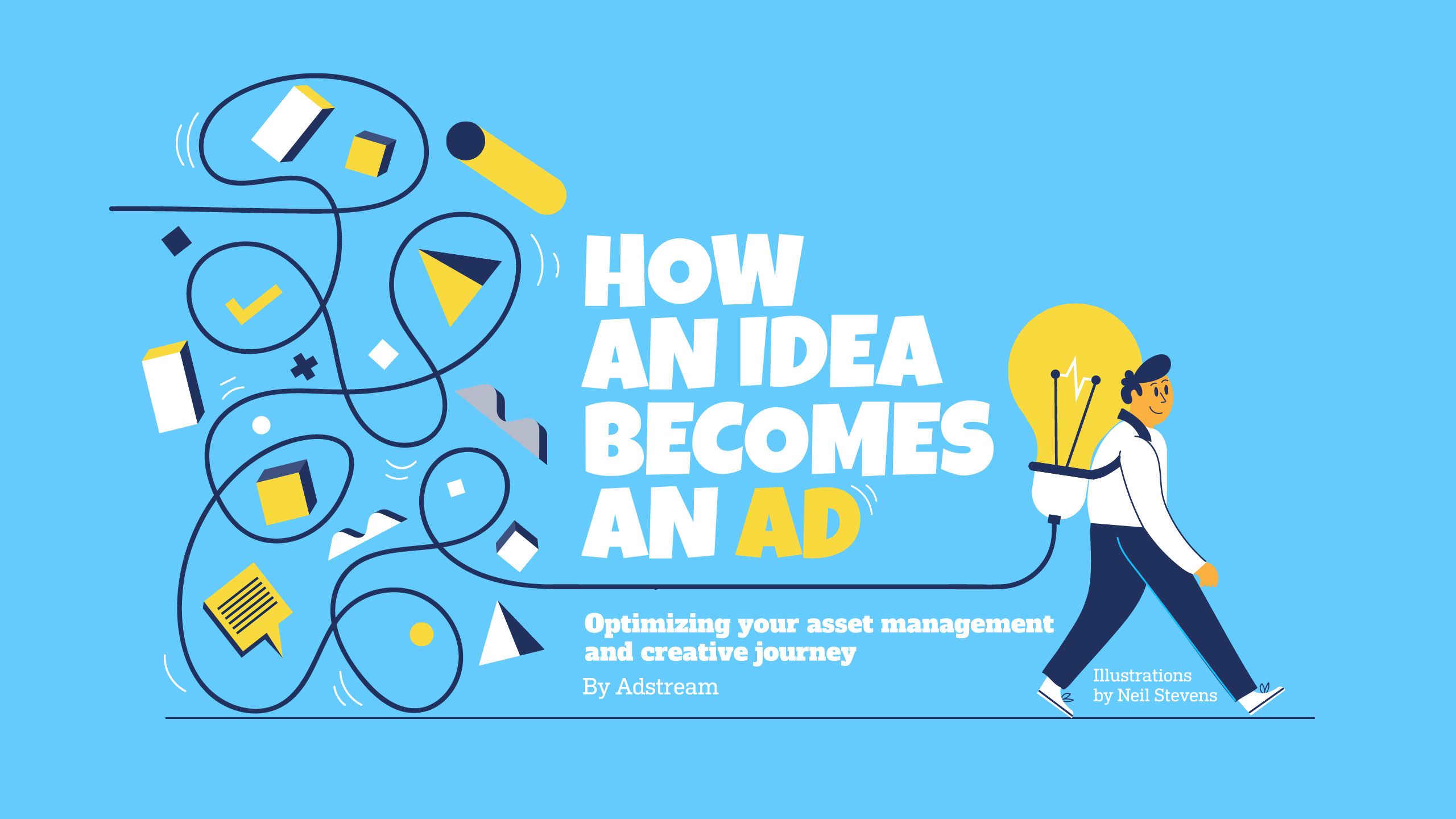
Like most things in modern life, technology has both tremendously improved upon and complicated the advertising supply chain. With a media environment that has exploded across touchpoints, channels and platforms, what used to be a simple process of getting an asset from point A to point B is now a cumbersome and siloed journey.
Brand and creative teams that used to be in charge of creating and deploying campaigns comprised of a dozen creative files now require hundreds to thousands of files that need to be distributed to destinations around the globe.
But this increased demand for content hasn’t necessarily come with increased resources. Marketers—being the savvy bunch they are—have taken to reusing assets wherever possible. While this does help cut costs, it can also quickly lead to usage rights violations and sloppy creative executions. That’s not to mention the waste created by teams under pressure to produce as many creative assets as possible.
To put it simply, marketers’ processes for creative and asset management haven’t kept up with the changing media landscape. It doesn’t need to be like this however. Ad delivery and asset management are primed for disruption in the form of centralized, streamlined procedures and automation.
So, what does the modern ad journey look like? And how can it be optimized to reduce costs, time and headaches? Let’s follow a creative asset on its journey from idea to full-blown campaign, showing you how to make your ad delivery process faster, more efficient and cost-effective at every step.



Before our asset can become a campaign, it needs to be airtight against expired creative rights and fully approved by all stakeholders.
Despite it being early in the process, this can be one of the most fraught stages. Why? Because in the push to churn out content faster, teams often lose track of versions and important notes and annotations get lost in shuffle.
The key to making this first step work is centralizing the production workflow. This means that all assets are stored in one central database that everyone has access to. Part of this centralization is saving all annotations, notes and versions with the asset. This way you can scroll through and see the asset’s entire history via a standardized taxonomy of the assets.
With everything in one place, the person in charge of final approvals can audit all aspects of the creative and clearly see the why and when behind any changes that were made.
A second aspect is the ability to keep usage rights tags attached to the asset. If this is done from the get-go, anyone who interacts with the asset down the line will be able to clearly see where, when and how it can be used.
Make sure you have a set criteria for what elements each asset needs to have. For example, you could include contract details, rates and contact information for the rights holder. This way, if anything goes wrong, all team members will be empowered to fix it before a fine can be levied. This goes for expired assets as well. With all assets in a central location, stakeholders can easily lock or limit access to anything that has expired rights attached to it.

Before our asset can become a campaign, it needs to be airtight against expired creative rights and fully approved by all stakeholders.
Despite it being early in the process, this can be one of the most fraught stages. Why? Because in the push to churn out content faster, teams often lose track of versions and important notes and annotations get lost in shuffle.

The key to making this first step work is centralizing the production workflow. This means that all assets are stored in one central database that everyone has access to. Part of this centralization is saving all annotations, notes and versions with the asset. This way you can scroll through and see the asset’s entire history via a standardized taxonomy of the assets.
With everything in one place, the person in charge of final approvals can audit all aspects of the creative and clearly see the why and when behind any changes that were made.
A second aspect is the ability to keep usage rights tags attached to the asset. If this is done from the get-go, anyone who interacts with the asset down the line will be able to clearly see where, when and how it can be used.
Make sure you have a set criteria for what elements each asset needs to have. For example, you could include contract details, rates and contact information for the rights holder. This way, if anything goes wrong, all team members will be empowered to fix it before a fine can be levied. This goes for expired assets as well. With all assets in a central location, stakeholders can easily lock or limit access to anything that has expired rights attached to it.

Whew, our asset has made it out of pre-production, but before it can be sent to its end destination, it needs to spend some time in quality control.
This doesn’t mean manually going over every color and typeface to ensure it complies with brand guidelines. To keep the process as efficient as possible, it’s important to look for places to automate with AI. One way to do this is by creating a central repository of specifications that every asset will be checked against.
For example, say your brand has a strict moratorium on sans serif fonts. If you specify that within your asset management system, any file that comes through with sans serif font will be automatically flagged and sent to the file owner for revision. Putting these automated and human quality controls in place ensures that every asset that goes out is as close to perfect as possible.
At this stage of the journey, having that top-down view of all assets is critical. If errors are flagged and sent back to the team for revision, you need to be able to see where exactly the asset is and when it will be done. Working with a system that can create automated, smart workflows that track activity and trigger deadline reminders can help you shorten the deployment timeline.
Last but not least for our burgeoning asset is metadata tagging. By defining and tagging all elements within an asset, you’ll be better positioned to reuse them if necessary while understanding where it’s been and when it was there.
Creating a cataloged, centralized system will also empower you to take action in a crisis. For example, when Covid-19 shuttered activity around the globe, many brands were running campaigns that encouraged consumers to get out and enjoy their product at a barbeque or concert. When shelter-in-place orders went into effect, those campaigns became tone-deaf and irrelevant overnight. Those brands that had a clear view of what assets were in the market could quickly react and turn off all irrelevant or insensitive messaging.

Whew, our asset has made it out of pre-production, but before it can be sent to its end destination, it needs to spend some time in quality control.
This doesn’t mean manually going over every color and typeface to ensure it complies with brand guidelines. To keep the process as efficient as possible, it’s important to look for places to automate with AI. One way to do this is by creating a central repository of specifications that every asset will be checked against.
For example, say your brand has a strict moratorium on sans serif fonts. If you specify that within your asset management system, any file that comes through with sans serif font will be automatically flagged and sent to the file owner for revision. Putting these automated and human quality controls in place ensures that every asset that goes out is as close to perfect as possible.

At this stage of the journey, having that top-down view of all assets is critical. If errors are flagged and sent back to the team for revision, you need to be able to see where exactly the asset is and when it will be done. Working with a system that can create automated, smart workflows that track activity and trigger deadline reminders can help you shorten the deployment timeline.
Last but not least for our burgeoning asset is metadata tagging. By defining and tagging all elements within an asset, you’ll be better positioned to reuse them if necessary while understanding where it’s been and when it was there.
Creating a cataloged, centralized system will also empower you to take action in a crisis. For example, when Covid-19 shuttered activity around the globe, many brands were running campaigns that encouraged consumers to get out and enjoy their product at a barbeque or concert. When shelter-in-place orders went into effect, those campaigns became tone-deaf and irrelevant overnight. Those brands that had a clear view of what assets were in the market could quickly react and turn off all irrelevant or insensitive messaging.

Now that our asset has been approved by all stakeholders and ran against quality specifications, it can be delivered to its endpoint.
This is yet another place where automation can save some serious time. But despite advancements in the technology, much of the creative industry still manually transcodes campaigns to meet different channel specifications.
Consider the current model—you have a connected TV commercial that’s part of a broader social and digital campaign. You need to disseminate it on all three platforms, but don’t have the budget or time to reproduce it for every medium. Instead of manually breaking it down and recreating it for every different social platform, you can simply feed it into an automated system that will convert it to meet specific channel requirements. Having a direct connection from your video editing software to your delivery pipeline will also help significantly reduce your deployment time.
This also applies to converting assets to foreign market requirements. If done by hand, it’s almost impossible to avoid errors. But by feeding the files into an automated system, you’ll be able to get them out faster and remove the chance of human error.
Of course, our asset doesn’t exist in a silo. Once it’s been transcoded and successfully delivered, it’s critical that you update your scheduling, booking and finance systems. After all, if an asset is delivered but no one outside of marketing knows it, was the asset every really delivered?
Instead of manually updating outside departments and systems, look for a tool that allows you to plug in other internal content management software. This way all databases will be automatically updated once the asset is sent out.

Now that our asset has been approved by all stakeholders and ran against quality specifications, it can be delivered to its endpoint.
This is yet another place where automation can save some serious time. But despite advancements in the technology, much of the creative industry still manually transcodes campaigns to meet different channel specifications.
Consider the current model—you have a connected TV commercial that’s part of a broader social and digital campaign. You need to disseminate it on all three platforms, but don’t have the budget or time to reproduce it for every medium. Instead of manually breaking it down and recreating it for every different social platform, you can simply feed it into an automated system that will convert it to meet specific channel requirements. Having a direct connection from your video editing software to your delivery pipeline will also help significantly reduce your deployment time.
This also applies to converting assets to foreign market requirements. If done by hand, it’s almost impossible to avoid errors. But by feeding the files into an automated system, you’ll be able to get them out faster and remove the chance of human error.

Of course, our asset doesn’t exist in a silo. Once it’s been transcoded and successfully delivered, it’s critical that you update your scheduling, booking and finance systems. After all, if an asset is delivered but no one outside of marketing knows it, was the asset every really delivered?
Instead of manually updating outside departments and systems, look for a tool that allows you to plug in other internal content management software. This way all databases will be automatically updated once the asset is sent out.

Our asset has been deployed and is now being shown to audiences around the world—but that doesn’t mean the work stops.
It’s time to dig deep, gauge performance and calculate your action return. Analyze which assets were created but not used, review production costs and make sure you have a system to keep track of all usage rights.
To eliminate waste before it has a chance to happen, use a tool that can give you an overview of which content was created and never used. With that view, you’ll be able to zoom in and see if there was, for example, excess photography, graphics or videos, who created them and used them or didn’t. With this information in hand, you can optimize your future productions and only create content you know will be used.
Having this kind of view of content consumption will also help you identify opportunities where assets can be reused for international markets or repurposed for future campaigns.
A second way to use data analytics to reduce waste is by consolidating all of your production, media and versioning costs into one dashboard. By seeing exactly what was spent and where you can identify unnecessary cost centers or places where things can be cut or automated out.
And last but not least, with campaigns out in the market you need to make sure you have a system in place that can keep track of all usage rights and expiration dates across markets. Ideally, this system will warn you well ahead of time to renew rights and can lock access to any asset that has expired contracts attached to it.
With this done, our asset’s journey has come to an end. As you can see, technology can complicate things, but when wielded with care, it can also simplify. To reduce waste, avoid usage rights fees and cut down on deployment timelines, it will be critical to pause and examine where and how asset management technology can help you.
. . .
About Adstream
Adstream is the first connectivity suite for the ad industry, combining collaboration tools, digital asset management, a global distribution network and powerful analytics to provide smarter, more collaborative advertising workflows. Adstream One allows you to manage, deliver and report on campaigns with absolute confidence through a powerful TV and cross-media advertising delivery platform with over 80,000 destinations worldwide.

Our asset has been deployed and is now being shown to audiences around the world—but that doesn’t mean the work stops.
It’s time to dig deep, gauge performance and calculate your action return. Analyze which assets were created but not used, review production costs and make sure you have a system to keep track of all usage rights.
To eliminate waste before it has a chance to happen, use a tool that can give you an overview of which content was created and never used. With that view, you’ll be able to zoom in and see if there was, for example, excess photography, graphics or videos, who created them and used them or didn’t. With this information in hand, you can optimize your future productions and only create content you know will be used.
Having this kind of view of content consumption will also help you identify opportunities where assets can be reused for international markets or repurposed for future campaigns.

A second way to use data analytics to reduce waste is by consolidating all of your production, media and versioning costs into one dashboard. By seeing exactly what was spent and where you can identify unnecessary cost centers or places where things can be cut or automated out.
And last but not least, with campaigns out in the market you need to make sure you have a system in place that can keep track of all usage rights and expiration dates across markets. Ideally, this system will warn you well ahead of time to renew rights and can lock access to any asset that has expired contracts attached to it.
With this done, our asset’s journey has come to an end. As you can see, technology can complicate things, but when wielded with care, it can also simplify. To reduce waste, avoid usage rights fees and cut down on deployment timelines, it will be critical to pause and examine where and how asset management technology can help you.
. . .
About Adstream
Adstream is the first connectivity suite for the ad industry, combining collaboration tools, digital asset management, a global distribution network and powerful analytics to provide smarter, more collaborative advertising workflows. Adstream One allows you to manage, deliver and report on campaigns with absolute confidence through a powerful TV and cross-media advertising delivery platform with over 80,000 destinations worldwide.



 Built with Shorthand
Built with Shorthand





